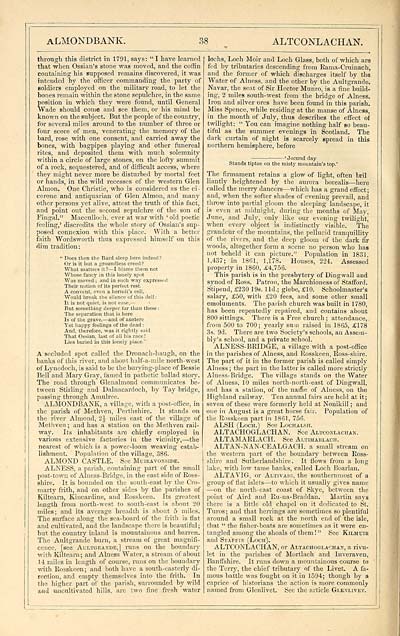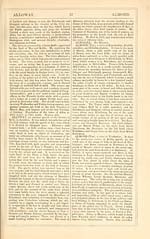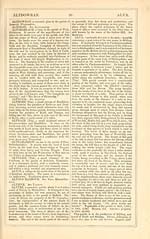Download files
Complete book:
Individual page:
Thumbnail gallery: Grid view | List view

ALMONDBANK.
38
ALTCONLACHAN.
through this district in 1791, says: "I have learned
that when Ossian's stone was moved, and the coffin
containing his supposed remains discovered, it was
intended by the officer commanding the party of
soldiers employed on the military road, to let the
bones remain within the stone sepulchre, in the same
position in which they were found, until General
Wade should come and see them, or his mind be
known on the subject. But the people of the country,
for several miles around to the number of three or
four score of men, venerating the memory of the
bard, rose with one consent, and carried away the
bones, with bagpipes playing and other funereal
rites, and deposited them with much solemnity
within a circle of large stones, on the lofty summit
of a rock, sequestered, and of difficult access, where
they might never more be disturbed by mortal feet
or hands, in the wild recesses of the western Glen
Almon. One Christie, who is considered as the ci-
cerone and antiquarian of Glen Almon, and many
other persons yet alive, attest the truth of this fact,
and point out the second sepulchre of the son of
Fingal." Macculloch, ever at war with ' old poetic
feeling,' discredits the whole story of Ossian's sup-
posed connexion with this place. With a better
faith Wordsworth thus expressed himself on this
dim tradition:
" Does then the Bard sleep here indeed ?
Or is it but a groundless creed?
What matters it? — I blame them not
Whose fancy in this lonely spot
Was moved ; and in such way expressed
Their notion of its perfect rest.
A convent, even a hermit's cell.
Would break the silence of this dell:
It is not quiet, is not ease, —
But something; deeper far than these:
The separation that is here
Is of the grave, — and of austere
Yet happy feelings of the dead :
And, therefore, was it rightly said
That Ossian, last of all his race!
Lies buried in this lonely place."
A secluded spot called the Dronach-haugh, on the
banks of this river, and about half-a-mile north-west
of Lynedoch, is said to be the burying-place of Bessie
Bell and Mary Gray, famed in pathetic ballad story.
The road through Glenalmond communicates be-
tween Stirling and Dalnacardoch, by Tay bridge,
passing through Amulree.
ALMONDBANK, a village, with a post-office, in
the parish of Methven, Perthshire. It stands on
the river Almond, 2i miles east of the village of
Methven ; and has a station on the Methven rail-
way. Its inhabitants are chiefly employed in
various extensive factories in the vicinity, — the
nearest of which is a power-loom weaving estab-
lishment. Population of the village, 386.
ALMOND CASTLE. See Muiravonside.
ALNESS, a parish, containing part of the small
post-town of Ainess-Bridge, in the east side of Ross-
shire. It is bounded on the south-east by the Cro-
marty frith, and on other sides by the parishes of
Kiltearn, Kincardine, and Rosskeen. Its greatest
length from north-west to south-east is about 20
miles; and its average breadth is about 5 miles.
The surface along the sea-board of the frith is flat
and cultivated, and the landscape there is beautiful;
but the country inland is mountainous and barren.
The Aultgrande burn, a stream of great magnifi-
cence, [see Aultgrande,] runs on the boundary
with Kiltearn; and Alness Water, a stream of about
14 miles in length of course, runs on the boundary
with Eosakeen ; and both have a south-easterly di-
rection, and empty themselves into the frith. In
the higher part of the parish, surrounded by wild
And uncultivated hills, are two fine fresh water
lochs, Loch Moir and Loch Glass, both of which are
fed by tributaries descending from Rama-Cruinach,
and the former of which discharges itself by tho
Water of Alness, and the other by the Aultgrande.
Navar, the seat of Sir Hector Munro, is a fine build-
ing, 2 miles south-west from the bridge of Alness.
Iron and silver ores have been found in this parish.
Miss Spence, while residing at the manse of Alness,
in the month of July, thus describes the effect of
twilight: " You can imagine nothing half so beau-
tiful as the summer evenings in Scotland. The
dark curtain of night is scarcely spread in this
northern hemisphere, before
—'Jocund day
Stands tiptoe on the misty mountain's top.'
The firmament retains a glow of light, often bril
liantly heightened by the aurora borealis — here
called the merry dancers — which has a grand effect;
and, when the softer shades of evening prevail, and
throw into partial gloom the sleeping landscape, it
is even at midnight, during the months of May,
June, and July, only like our evening twilight,
when every object is indistinctly visible. The
grandeur of the mountains, the pellucid tranquillity
of the rivers, and the deep gloom of the dark fir
woods, altogether form a scene no person who has
not beheld it can picture." Population in 1831,
1,437; in 1861, 1,178. Houses, 224. Assessed
property in 1860, i.'4,756.
This parish is in the presbytery of Dingwall and
synod of Ross. Patron, the Marchioness of Stafford.
Stipend, £230 19s. lid.; glebe, £10. Schoolmaster's
salary, £50, with £20 fees, and some other small
emoluments. The parish church was built in 1780,
has been repeatedly repaired, and contains about
800 sittings. There is a Free church ; attendance,
from 500 to 700; yearly sum raised in 1865, £178
3s. 9d. There are two Society's schools, an Assem-
bly's school, and a private 3chool.
ALNESS-BRIDGE, a village with a post-office
in the parishes of Alness, and Rosskeen, Ross-shire.
The part of it in the former parish is called simply
Alness ; the part in the latter is called more strictly
Alness-Bridge. The village stands on the Water
of Alness, 10 miles north-north-east of Dingwall,
and has a station, of the naine of Alness, on the
Highland railway. Ten annual fairs are held at it;
seven of these were formerly held at Nonikill ; and
one in August is a great horse fair. Population of
the Russkeen part in 1861, 756.
ALSH (Loch.) See Lochalsh.
ALTACHOGLACHAN. See Altconlachan.
ALTAMARLACH. See ALTniAjiLAcn.
ALTAN-NAN-CEALGACH. a small stream on
the western part of the boundary between Ross-
shire and Sutherlandshire. It flows from a long
lake, with low tame banks, called Loch Boarlan.
ALTAVIG, or Altivajg, the southernmost of a
group of flat islets — to which it usually gives name
— on the north-east coast of Skye, between the
point of Aird and Ru-na-Braddan. Martin says
there is a little old chapel on it dedicated to St.
Turos; and that herrings are sometimes so plentiful
around a small rock at the north end of the isle,
that " the fisher- boats are sometimes as it were en-
tangled among the shoals of them ! " See Kilmuib
and Staffin (Loch).
ALTCONLACHAN, or Altachoglachan, a rivu-
let in the parishes of Mortlach and Inveraven,
Banffshire. It runs down a mountainous course to
the Terry, the chief tributary of the Livet. A fa-
mous battle was fought on it in 1594; though by a
caprice of historians the action is more commonly
named from Glenlivet. See the article Gi.enlivet.
38
ALTCONLACHAN.
through this district in 1791, says: "I have learned
that when Ossian's stone was moved, and the coffin
containing his supposed remains discovered, it was
intended by the officer commanding the party of
soldiers employed on the military road, to let the
bones remain within the stone sepulchre, in the same
position in which they were found, until General
Wade should come and see them, or his mind be
known on the subject. But the people of the country,
for several miles around to the number of three or
four score of men, venerating the memory of the
bard, rose with one consent, and carried away the
bones, with bagpipes playing and other funereal
rites, and deposited them with much solemnity
within a circle of large stones, on the lofty summit
of a rock, sequestered, and of difficult access, where
they might never more be disturbed by mortal feet
or hands, in the wild recesses of the western Glen
Almon. One Christie, who is considered as the ci-
cerone and antiquarian of Glen Almon, and many
other persons yet alive, attest the truth of this fact,
and point out the second sepulchre of the son of
Fingal." Macculloch, ever at war with ' old poetic
feeling,' discredits the whole story of Ossian's sup-
posed connexion with this place. With a better
faith Wordsworth thus expressed himself on this
dim tradition:
" Does then the Bard sleep here indeed ?
Or is it but a groundless creed?
What matters it? — I blame them not
Whose fancy in this lonely spot
Was moved ; and in such way expressed
Their notion of its perfect rest.
A convent, even a hermit's cell.
Would break the silence of this dell:
It is not quiet, is not ease, —
But something; deeper far than these:
The separation that is here
Is of the grave, — and of austere
Yet happy feelings of the dead :
And, therefore, was it rightly said
That Ossian, last of all his race!
Lies buried in this lonely place."
A secluded spot called the Dronach-haugh, on the
banks of this river, and about half-a-mile north-west
of Lynedoch, is said to be the burying-place of Bessie
Bell and Mary Gray, famed in pathetic ballad story.
The road through Glenalmond communicates be-
tween Stirling and Dalnacardoch, by Tay bridge,
passing through Amulree.
ALMONDBANK, a village, with a post-office, in
the parish of Methven, Perthshire. It stands on
the river Almond, 2i miles east of the village of
Methven ; and has a station on the Methven rail-
way. Its inhabitants are chiefly employed in
various extensive factories in the vicinity, — the
nearest of which is a power-loom weaving estab-
lishment. Population of the village, 386.
ALMOND CASTLE. See Muiravonside.
ALNESS, a parish, containing part of the small
post-town of Ainess-Bridge, in the east side of Ross-
shire. It is bounded on the south-east by the Cro-
marty frith, and on other sides by the parishes of
Kiltearn, Kincardine, and Rosskeen. Its greatest
length from north-west to south-east is about 20
miles; and its average breadth is about 5 miles.
The surface along the sea-board of the frith is flat
and cultivated, and the landscape there is beautiful;
but the country inland is mountainous and barren.
The Aultgrande burn, a stream of great magnifi-
cence, [see Aultgrande,] runs on the boundary
with Kiltearn; and Alness Water, a stream of about
14 miles in length of course, runs on the boundary
with Eosakeen ; and both have a south-easterly di-
rection, and empty themselves into the frith. In
the higher part of the parish, surrounded by wild
And uncultivated hills, are two fine fresh water
lochs, Loch Moir and Loch Glass, both of which are
fed by tributaries descending from Rama-Cruinach,
and the former of which discharges itself by tho
Water of Alness, and the other by the Aultgrande.
Navar, the seat of Sir Hector Munro, is a fine build-
ing, 2 miles south-west from the bridge of Alness.
Iron and silver ores have been found in this parish.
Miss Spence, while residing at the manse of Alness,
in the month of July, thus describes the effect of
twilight: " You can imagine nothing half so beau-
tiful as the summer evenings in Scotland. The
dark curtain of night is scarcely spread in this
northern hemisphere, before
—'Jocund day
Stands tiptoe on the misty mountain's top.'
The firmament retains a glow of light, often bril
liantly heightened by the aurora borealis — here
called the merry dancers — which has a grand effect;
and, when the softer shades of evening prevail, and
throw into partial gloom the sleeping landscape, it
is even at midnight, during the months of May,
June, and July, only like our evening twilight,
when every object is indistinctly visible. The
grandeur of the mountains, the pellucid tranquillity
of the rivers, and the deep gloom of the dark fir
woods, altogether form a scene no person who has
not beheld it can picture." Population in 1831,
1,437; in 1861, 1,178. Houses, 224. Assessed
property in 1860, i.'4,756.
This parish is in the presbytery of Dingwall and
synod of Ross. Patron, the Marchioness of Stafford.
Stipend, £230 19s. lid.; glebe, £10. Schoolmaster's
salary, £50, with £20 fees, and some other small
emoluments. The parish church was built in 1780,
has been repeatedly repaired, and contains about
800 sittings. There is a Free church ; attendance,
from 500 to 700; yearly sum raised in 1865, £178
3s. 9d. There are two Society's schools, an Assem-
bly's school, and a private 3chool.
ALNESS-BRIDGE, a village with a post-office
in the parishes of Alness, and Rosskeen, Ross-shire.
The part of it in the former parish is called simply
Alness ; the part in the latter is called more strictly
Alness-Bridge. The village stands on the Water
of Alness, 10 miles north-north-east of Dingwall,
and has a station, of the naine of Alness, on the
Highland railway. Ten annual fairs are held at it;
seven of these were formerly held at Nonikill ; and
one in August is a great horse fair. Population of
the Russkeen part in 1861, 756.
ALSH (Loch.) See Lochalsh.
ALTACHOGLACHAN. See Altconlachan.
ALTAMARLACH. See ALTniAjiLAcn.
ALTAN-NAN-CEALGACH. a small stream on
the western part of the boundary between Ross-
shire and Sutherlandshire. It flows from a long
lake, with low tame banks, called Loch Boarlan.
ALTAVIG, or Altivajg, the southernmost of a
group of flat islets — to which it usually gives name
— on the north-east coast of Skye, between the
point of Aird and Ru-na-Braddan. Martin says
there is a little old chapel on it dedicated to St.
Turos; and that herrings are sometimes so plentiful
around a small rock at the north end of the isle,
that " the fisher- boats are sometimes as it were en-
tangled among the shoals of them ! " See Kilmuib
and Staffin (Loch).
ALTCONLACHAN, or Altachoglachan, a rivu-
let in the parishes of Mortlach and Inveraven,
Banffshire. It runs down a mountainous course to
the Terry, the chief tributary of the Livet. A fa-
mous battle was fought on it in 1594; though by a
caprice of historians the action is more commonly
named from Glenlivet. See the article Gi.enlivet.
Set display mode to: Large image | Transcription
Images and transcriptions on this page, including medium image downloads, may be used under the Creative Commons Attribution 4.0 International Licence unless otherwise stated. ![]()
| Gazetteers of Scotland, 1803-1901 > Imperial gazeteer of Scotland, or, Dictionary of Scottish topography > Volume 1 > (128) Page 38 |
|---|
| Permanent URL | https://digital.nls.uk/97460666 |
|---|
| Description | Volume I: Aan-Gordon. |
|---|---|
| Attribution and copyright: |
|

